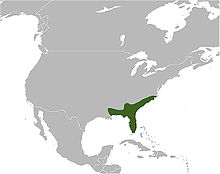Diamond rattlesnake
| Diamond rattlesnake | ||||||||||||
|---|---|---|---|---|---|---|---|---|---|---|---|---|

Diamond rattlesnake ( Crotalus adamanteus ) |
||||||||||||
| Systematics | ||||||||||||
|
||||||||||||
| Scientific name | ||||||||||||
| Crotalus adamanteus | ||||||||||||
| Palisot de Beauvois , 1799 |
The diamond rattlesnake ( Crotalus adamanteus ) is a species of rattlesnake found in the southeastern United States . With a maximum total length of 2.50 meters, it is the longest rattlesnake species.
features
The diamond rattlesnake is usually about 1.20 to 1.40 meters long, in exceptional cases it can reach maximum lengths of 2.0 to 2.50 meters. The body color ranges from gray to a light olive green with clear diamond-shaped and dark brown drawing elements on the back (" diamonds "). The diamonds are surrounded by a row of creamy white scales . The head is also mostly dark brown in color and has two light stripes on both sides, one above and one below the eye diagonally downwards. The eye stripe in between is very dark, often black. The snake also has lighter stripes on the sides of its snout. Like all rattlesnakes, it has a noticeable tail rattle .
distribution and habitat
The distribution area of the diamond rattlesnake is limited to the southeastern United States and includes Florida , the extreme southeast of Louisiana (where it may already be extinct today) and the southern coastal regions of Alabama , Georgia , North and South Carolina .
As a habitat , the snake prefers dry pine and oak forests , often interspersed with the scrub palmetto, in spite of the lowland marshland that predominates in its area of distribution . However, the rattlesnake is also a good swimmer and has been found several kilometers off the coast in the open sea. Accordingly, they can also be found on many offshore islands and the Florida Keys .
Way of life
Like most other species of rattlesnakes, this species is also primarily active at night and at dawn and lives exclusively on the ground. It feeds mainly on small mammals , more rarely on lizards or birds, which it kills with its bite.
In the event of a potential threat, the snake tries to flee or behaves calmly and trusts its camouflage . If the threat becomes more intense, the snake can use its rattle as a warning, making a loud rattling noise. In most cases, a defensive bite follows after this, which is almost always associated with an injection of poison.
The viviparous ( ovoviviparous ) diamond rattlesnakes give birth to between seven and 21 young snakes per litter, which are already 30 to 36 centimeters long at birth. In the case of a snake kept in a terrarium, genetic markers were used to prove that it did not produce 19 young animals from fertilized egg cells until five years after the last contact with a conspecific.
Snake venom
As the largest rattlesnake, the diamond rattlesnake also has a greater amount of venom than any other species in the genus. The poison attacks the red blood cells and destroys them, and it also leads to tissue destruction in the area of the bite, which swells a lot. If left untreated, the bite can have very serious consequences for the patient and can even lead to death.
Antivenins , which can be used unspecifically for bites by rattlesnakes, are especially available for keeping in terrariums . A well-known preparation is "CroFab (Crotalidae Polyvalent Immune [Ovine])".
Hazardous situation
The International Union for Conservation of Nature IUCN has the diamond rattlesnake on the Red List of Endangered Species . However, due to its widespread use and the presumably high population, it is assessed as not at risk ( least concern ).
literature
- Chris Mattison: Rattlers! - A natural history of rattlesnakes. Blandford, London 1996, ISBN 0-7137-2534-6
- Dieter Schmidt: snakes. Biology, species, terraristics. bede-Verlag, Ruhmannsfelden 2006, ISBN 3-89860-115-3
Web links
Individual evidence
- ^ Warren Booth, Gordon W. Schuett: Molecular genetic evidence for alternative reproductive strategies in North American pitvipers (Serpentes: Viperidae): long-term sperm storage and facultative parthenogenesis. In: Biological Journal of the Linnean Society , Volume 104, No. 4, 2011, pp. 934-942, DOI: 10.1111 / j.1095-8312.2011.01782.x
- ↑ Crotalus adamanteus in the endangered Red List species the IUCN 2009. Posted by: Hammerson, GA, 2007. Accessed on March 8 of 2010.

